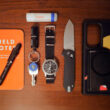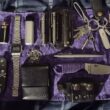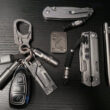Today’s new carabiners have come a long way since their original use as part of a climber’s tool kit, transformed into nifty tools that help round out and make your EDC kit work. Spring-loaded mechanisms make it easy to latch them onto your clothing or bags, turning them into helpful linking devices that make your different everyday essentials more accessible and easier to carry. Whether it’s an effective way to carry your keys or a convenient way to attach your essentials to your pack or your person, we’ve covered you in this guide.
NOTE: These products are meant to carry an assortment of your gear. The original climbing carabiners inspired some designs, but not all of them are rated to bear heavy loads. Review your requirements before buying and ensure you’re using the right carabiner for the job.
Our Top Picks
The Best Overall Carabiner: Petzl Attache [Buy]
The Best Carabiner on a Budget: Black Diamond HotForge Screwgate [Buy]
The Best Carabiner for EDC: Heroclip [Buy]
The Best Carabiner for Sport Climbing: EDELRID HMS Strike [Buy]
The Best Carabiner for Trad Climbing: Black Diamond RockLock Twistlock [Buy]
Petzl Attache | Black Diamond HotForge Screwgate | Heroclip | EDELRID HMS Strike | Black Diamond RockLock |
 |  |  |  |  |
| $ | $ | $ | $ | $ |
| Length: 5.51″ | Length: 6.3″ | Length: 3″ | Length: 3.5″ | Length: 3.9″ |
| Weight: 2.11 oz | Weight: 1 oz | Weight: 2 oz | Weight: 2.3 oz | Weight: 3 oz |
| Key Features: Optimized for belaying | Key Features: Screwgate sleeve | Key Features: 3-in-1 clip and hook | Key Features: Ideal for alpine climbing | Key Features: Hot-forged for lighter-weight construction |
| Buy Now | Buy Now | Buy Now | Buy Now |

Petzl Attache Carabiner
Purchase
DMM Alpha Trad Carabiner
Purchase
Black Diamond RockLock Carabiner
Purchase
EDELRID HMS Strike Locking Carabiner
Purchase
Heroclip Carabiner
Purchase
Nite Ize S-Biner SlideLock Carabiner
Purchase
RovyVon U4 Carabiner
Purchase
Black Diamond HotForge Screwgate Carabiner
Purchase
James Brand The Mehlville
Purchase
CRKT Compano
Purchase
GPCA Carabiner Pro
Purchase
BLANK FORCES HyperLink Carabiner
Purchase
Handgrey H6 Carabiner
Purchase
KeyBar KeyVice Carabiner
Purchase
Dango Carabiner and Shackle
PurchaseHow to Choose the Best Carabiner
Carabiners exist in many different types, shapes, and sizes due to their versatile nature. Some might be more suited for EDC as a hanging point for your keys and gear. Others were designed as tools of paramount importance when climbing. Below, we’ll show you the characteristics you should consider when purchasing a carabiner.
Use Case
- Everyday use: Small, portable carabiners with additional tools like bottle openers or screwdrivers. They’re used as hanging points for backpacks, coats, or purses. They also attach your keys to your belt or some gear to another.
- Belaying and rappelling: Large, pear-shaped locking carabiners. Belaying is a variety of techniques used to create friction within a climbing system, particularly on a climbing rope, so that a climber does not fall very far or fast. This system is created with these carabiners.
- Quickdraws: Asymmetric D carabiners with straight, bent, and wire gates. A quickdraw consists of two carabiners connected by a semi-rigid material. One carabiner has a straight gate and connects to an anchoring device, while the other is for the climbing rope and uses a bent gate.
- Racking trad gear: Asymmetric D, D, or oval carabiners. A “trad rack” is the equipment climbers need to keep themselves safe during “traditional” climbing. Carabiners allow you to easily clip the rope into the protection you’ve just placed.
Locking carabiner vs. non-locking carabiner
Locking carabiners are best used when you want an extra step for safety. They usually include a protective sleeve or lock that requires additional steps for opening, giving their operators extra peace of mind. This does mean that by design they’re “slower” to use. For quickdraws, a lot of people prefer non-locking carabiners instead.
Gate type
- Straight: These are the most common carabiner type due to their versatility and reliability. They feature a straight piece of metal, straight from hinge to closure.
- Bent: Since the shape of the gate makes clipping and unclipping significantly easier, bent gate carabiners are perfect for quickdraws. Keep in mind that bent gate carabiners shouldn’t be used for clipping directly into protective gear as their nature makes them more prone to accidental unclipping.
- Wire: Wire gates can come in both straight or bent designs. However, some people prefer wire gates over traditional gates due to their superior resistance to corrosion, snow, and freezing. Their wire construction also means less mass, which in turn means significantly lighter weight.
Shape
- D-shape: These are generally the strongest carabiners out of the three. Their design directs force away from the gate and points it towards the spine instead. This shape excels at quickdraws, clipping protection equipment, and locking anchor points. They also tend to be more expensive.
- Oval: The oldest design of all, the oval shape has been around for quite a while. Oval-shaped carabiners are inexpensive and more accessible to rack and manipulate due to their symmetry. However, this also makes it so that they transfer force equally between the gate and the spine, making them weaker in comparison.
- Pear-shape: Also referred to as HMS carabiners, these are larger versions of D-shaped carabiners. Their oversized nature makes them excel at belaying tasks. Just like the oval carabiners, they tend to be weaker due to how they distribute force. However, they compensate for it by using thicker, more robust materials for the spine.
Certifications
For such a potentially dangerous activity, your gear needs to have certifications, ensuring that the carabiner will be strong enough to hold your weight or more in the event of a mishap. On the spine of every certified carabiner, there will be a CE and/or UIAA icon.
CE stands for European Conformity (translated from French). In broad terms, CE certifications are required by the European Commission to establish specific safety standards. They help ensure carabiners are strong enough to climb on.
The UIAA is the first and foremost developer of global climbing and mountaineering equipment standards. The UIAA board is made up of climbers and manufacturers. The UIAA has an online database where you can search and confirm each model name of a particular brand is UIAA certified.
Since Brexit, England, Scotland, and Wales have created their CE-equivalent standard, the UKCA.
Carabiner FAQs
With so many types, shapes and sizes, understanding carabiners can sometimes be a little confusing. Below you’ll find answers to some of the most frequently asked questions about carabiners:
When should I retire a carabiner?
The best time to retire a carabiner is if the body has any type of crack, if the locking mechanism seems excessively worn or if the gate doesn’t function properly anymore.
Is a carabiner a good gift for a climber?
Carabiners can make excellent gifts for climbers. Make sure you research the product and your giftee’s climbing habits to give a biner that meets their needs.
What is the difference between a D and an HMS carabiner?
D-shaped carabiners transfer more force away from the gate towards the spine, making them the strongest type of carabiner. HMS (or pear-shaped) carabiners are oversized versions of the offset D-shape optimized for belaying.
What is a locking carabiner?
Locking carabiners have a mechanism that can lock the gate in a closed position, protecting against accidental gate openings.
How we picked
Decades of experience and deep connections in the everyday carry industry give us a unique viewpoint on the market to inform our product recommendations. We have the depth of information for thousands of products that have come before and an extensive eye on the market to see what’s new and trending for each piece of gear. The result is a buying guide that we feel is informative and useful for EDCers of every trade, industry, and budget.
What is Everyday Carry?
Everyday Carry is both the concept of what people carry in their pockets and the process of picking out gear that thoughtfully considers what one wants or needs in their daily lives. It encompasses everything from style to preparedness to utility, meaning an entire industry full of valuable tools and essentials to choose from.
Why you should trust us
Our team has decades of combined experience in all aspects of everyday men’s essentials, from wallets to pens to bags and everything in between, and we know where to find great gear ideas that you may not come across at your local stores or when shopping online. Our expertise with the industry and familiarity in design, materials, and usability help you make more informed choices when it comes to picking up your next piece of gear.









